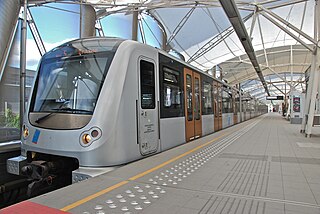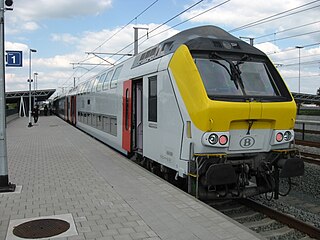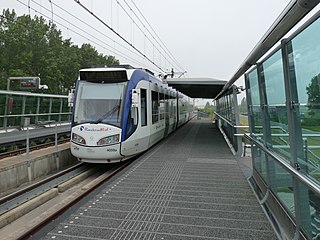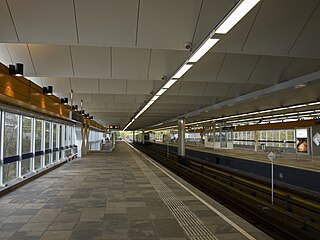
Commuter rail or suburban rail is a passenger rail transport service that primarily operates within a metropolitan area, connecting commuters to a central city from adjacent suburbs or commuter towns. Commuter rail systems can use locomotive-hauled trains or multiple units, using electric or diesel propulsion. Distance charges or zone pricing may be used.

Hook of Holland is a coastal village in the southwestern corner of Holland, hence the name; hoek means "corner" and was in use before the word kaap – "cape". The English translation using Hook is a false cognate of the Dutch Hoek, but has become commonplace. It is located at the mouth of the New Waterway shipping canal into the North Sea. The village is administered as a district of the municipality of Rotterdam. Its district covers an area of 18.53 km2, of which 14.19 km2 is land. On 1 January 2023 it had an estimated population of 10,560.

A cross-platform interchange is a type of interchange between different lines at a metro station. The term originates with the London Underground; such layouts exist in other networks but are not commonly so named. In the United States and Canada, it is often referred to as a cross-platform transfer.

The Brussels Metro is a rapid transit system serving a large part of the Brussels-Capital Region of Belgium. It consists of four conventional metro lines and three premetro lines. The metro-grade lines are M1, M2, M5, and M6 with some shared sections, covering a total of 39.9 kilometres (24.8 mi), with 59 metro-only stations. The premetro network consists of three tram lines that partly travel over underground sections that were intended to be eventually converted into metro lines. Underground stations in the premetro network use the same design as metro stations. A few short underground tramway sections exist, so there is a total of 52.0 kilometres (32.3 mi) of underground metro and tram network. There are a total of 69 metro and premetro stations as of 2011.

The Amsterdam Metro is a rapid transit system serving Amsterdam, Netherlands, and extending to the surrounding municipalities of Diemen and Ouder-Amstel. Until 2019, it also served the municipality of Amstelveen, but this route was closed and converted into a tram line. The network is owned by the City of Amsterdam and operated by municipal public transport company Gemeente Vervoerbedrijf (GVB), which also operates trams, free ferries and local buses.

Belgium has an extensive rail network. It is a member of the International Union of Railways (UIC). The UIC Country Code for Belgium is 88.

A ghost station is a disused train station through which revenue-service passenger trains pass but at which they do not stop. The term is also sometimes used for any unused underground station or any unused station, whether or not trains pass through them. In Germany, a station that has been built in the course of constructing something else as a so-called "Bauvorleistung" is referred to as a "ghost station", despite the different purpose and origin of the terms. Some English-language publications also refer to "pre-built" stations or parts thereof that have yet to see service as "ghost stations".

The Los Angeles Metro Rail is an urban rail transit system serving Los Angeles County, California, United States, consisting of six lines: four light rail lines and two rapid transit lines, serving a total of 102 stations. The system connects with the Metro Busway bus rapid transit system, the Metrolink commuter rail system, as well as several Amtrak lines. Metro Rail is owned and operated by the Los Angeles County Metropolitan Transportation Authority (Metro).

RandstadRail is a tram-train network in the Rotterdam–The Hague metropolitan area in the west of the Netherlands that is jointly operated by HTM Personenvervoer (HTM) and Rotterdamse Elektrische Tram (RET). It connects the cities of Rotterdam, The Hague and Zoetermeer, primarily using former train and existing tram tracks.

Den Haag Centraal is the largest railway station in the city of The Hague in South Holland, Netherlands, and with twelve tracks, the largest terminal station in the Netherlands. The railway station opened in 1973, adjacent to its predecessor: Den Haag Staatsspoor, which was subsequently demolished. It is the western terminus of the Gouda–Den Haag railway.

The Rotterdam Metro is a rapid transit system operated in Rotterdam, Netherlands and surrounding municipalities by RET. The first line, called Noord – Zuidlijn opened in 1968 and ran from Centraal Station to Zuidplein, crossing the river Nieuwe Maas in a tunnel. It was the first metro system to open in the Netherlands. At the time it was also one of the shortest metro lines in the world with a length of only 5.9 km (3.7 mi).

A medium-capacity system (MCS), also known as light rapid transit or light metro, is a rail transport system with a capacity greater than light rail, but less than typical heavy-rail rapid transit. MCS trains are usually 1 to 4 cars. Most medium-capacity rail systems are automated or use light-rail type vehicles.

The history of rapid transit began in London with the opening of the Metropolitan Railway, which is now part of the London Underground, in 1863. By World War I, electric underground railways were being used in Athens, Berlin, Boston, Buenos Aires, Budapest, Glasgow, Hamburg, Istanbul, Liverpool, New York City, Paris, and Philadelphia.

Rapid transit or mass rapid transit (MRT) or heavy rail, commonly referred to as metro, is a type of high-capacity public transport that is generally built in urban areas. A grade separated rapid transit line below ground surface through a tunnel can be regionally called a subway, tube, metro or underground. They are sometimes grade-separated on elevated railways, in which case some are referred to as el trains – short for "elevated" – or skytrains. Rapid transit systems are railways, usually electric, that unlike buses or trams operate on an exclusive right-of-way, which cannot be accessed by pedestrians or other vehicles.

Rotterdam Centraal station is the main railway station of the city Rotterdam in South Holland, Netherlands. The station received an average of 112,000 passengers daily in 2019. The current station building, located at Station Square, was officially opened in March 2014.

Slinge is an above-ground subway station in the south of the city of Rotterdam. It is part of Rotterdam Metro lines D and E. Slinge is the southern terminus of line E, while line D trains continue towards De Akkers station.

The Rotterdam tramway network is a key element of the overall public transport arrangements in Rotterdam, Netherlands.

Weesperplein is an underground metro station in the city centre of Amsterdam, Netherlands. Served by lines 51, 53, and 54 of the Amsterdam Metro, it was constructed using caissons with a length and width of 40 metres (130 ft). It has two floors: the upper floor, with a station hall and stores, and the lower floor, containing the tracks. Construction started in August 1970, and the first test rides passed through in January 1977. Extensive tests were carried out in September that year before it opened on 16 October.

Wuxi Metro is the rapid transit system of Wuxi, Jiangsu province, China. Line 1 began operations on 1 July 2014, and Line 2 on 28 December 2014. Line 3 opened on 28 October 2020. Line 4 opened on 17 December 2021.



















